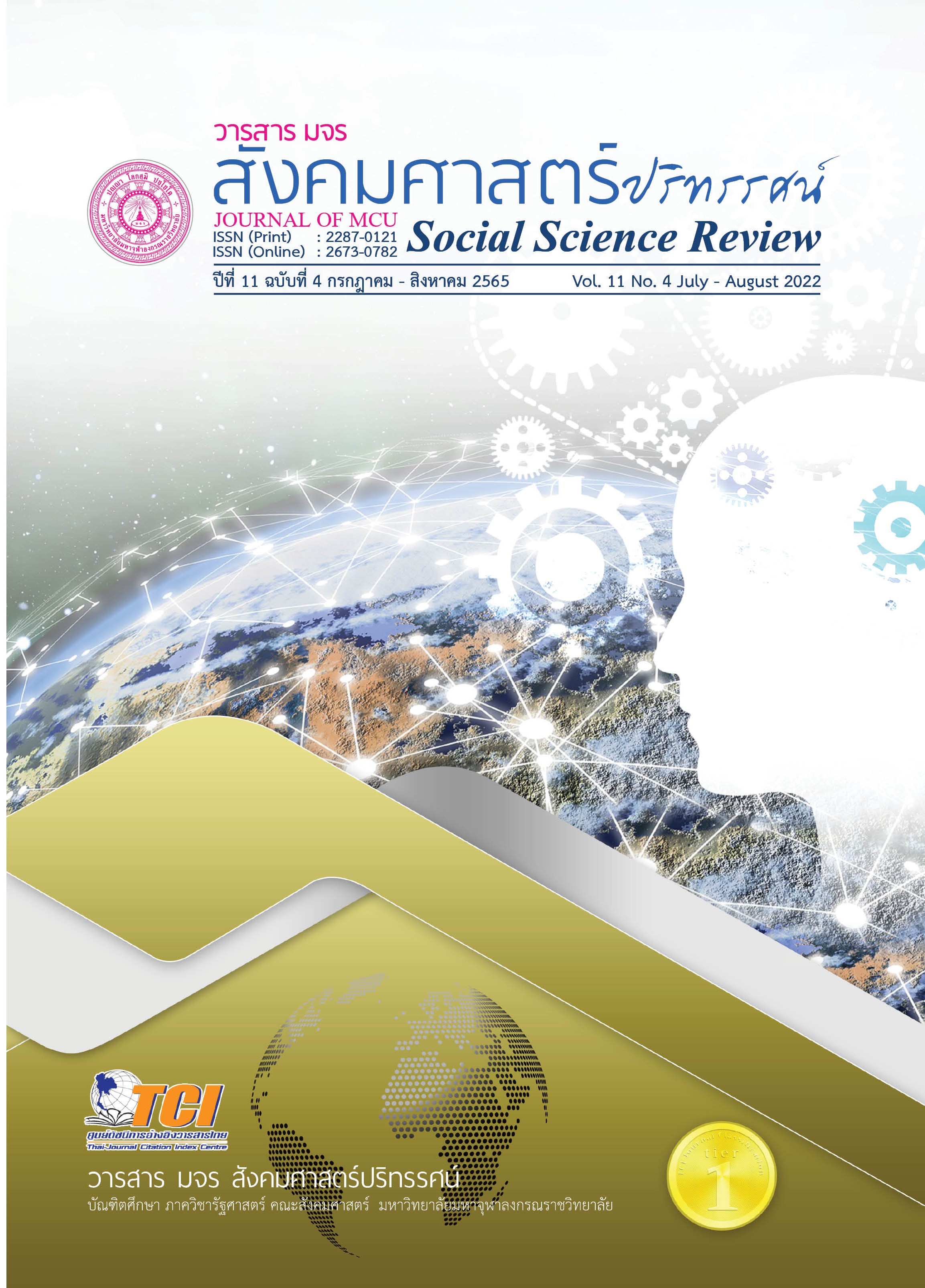การบริหารจัดการทรัพยากรน้ำในจังหวัดปทุมธานี
คำสำคัญ:
การบริหารจัดการ, ทรัพยากรน้ำ, จังหวัดปทุมธานีบทคัดย่อ
บทความนี้มีวัตถุประสงค์เพื่อศึกษาสภาพทั่วไป ปัจจัยที่ส่งผลต่อการบริหารจัดการทรัพยากรน้ำในพื้นที่จังหวัดปทุมธานี และนำเสนอการพัฒนาการบริหารจัดการทรัพยากรน้ำในพื้นที่จังหวัดปทุมธานี เป็นการวิจัยแบบผสานวิธี การวิจัยเชิงปริมาณเก็บข้อมูลด้วยแบบสอบถามจำนวน 306 คน วิเคราะห์ข้อมูลด้วยสถิติพรรณนา การวิจัยเชิงคุณคุณภาพ ผู้ให้ข้อมูลสำคัญ จำนวน 15 คน และสนทนากลุ่มเฉพาะ (Focus Group Discussion) จำนวน 10 รูป เก็บข้อมูลด้วยการสัมภาษณ์ วิเคราะห์ข้อมูลโดยวิธีการพรรณนาความ
ผลการวิจัยพบว่า 1. สภาพทั่วไปของการบริหารจัดการทรัพยากรน้ำในพื้นที่จังหวัดปทุมธานี มีการบริหารตามหลักการบริหารแบบ 4 M’s ด้าน คือ ด้านการบริหารงาน ด้านบุคลากร ด้านเครื่องจักรและอุปกรณ์ และด้านงบประมาณ ตามลำดับ 2. ปัจจัยที่ส่งผลต่อการบริหารจัดการทรัพยากรน้ำ ได้แก่ ยุทธศาสตร์ โครงสร้างองค์กร ความพร้อมของระบบงาน ภาวะผู้นำ การมีส่วนร่วมของบุคลากร ค่านิยมร่วม ปัจจัยที่ส่งผลต่อการบริหารจัดการน้ำมากที่สุดได้แก่ ด้านภาวะผู้นำ ด้านโครงสร้างองค์กร ร่วมกับทักษะของบุคลากร มีอิทธิพลต่อการบริหารจัดการทรัพยากรน้ำในพื้นที่จังหวัดปทุมธานี ร้อยละ 71.40 3. การพัฒนาการบริหารจัดการทรัพยากรน้ำ ได้แก่ การบริหารแบบมีส่วนร่วมทั้งจากหน่วยงานภาครัฐ ภาคเอกชนและภาคประชาชน ด้านรณรงค์ด้วยการประชาสัมพันธ์ให้ข้อมูลข่าวสารเพื่อช่วยกันลดผลกระทบทางลบต่อแหล่งน้ำธรรมชาติ การอนุรักษ์แหล่งน้ำด้วยเทคโนโลยีใหม่ๆ ตามลำดับ มีความสำคัญในระดับปานกลางที่ค่าเฉลี่ย 3.40
เอกสารอ้างอิง
ขนิษฐ ชีวะประไพและคณะ (2565). การบริหารจัดการขยะโดยใช้พลังงานทางเลือกขององค์การบริหารส่วนตำบลท่ามะนาว อำเภอชัยบาดาล จังหวัดลพบุรี. วารสารสหวิทยาการนวัตกรรมปริทรรศน์, 5(1), 1-12.
จิตตานันท์ ติกุล และคณะ. (2559). รูปแบบการบริหารจัดการที่เหมาะสมของศูนย์เชี่ยวชาญเฉพาะทาง มหาวิทยาลัยเทคโนโลยีสุรนารี (รายงานวิจัย). นครราชสีมา: มหาวิทยาลัยเทคโนโลยีสุรนารี.
ชลธร ทิพย์สุวรรณ. (2557). การบริหารจัดการทรัพยากรน้ำแบบบูรณาการลุ่มน้ำสาขาแม่ริม จังหวัดเชียงใหม่. (วิทยานิพนธ์ปรัชญาดุษฎีบัณฑิต สาขาวิชาภูมิภาคลุ่มน้ำโขงและสาละวินศึกษา). เชียงใหม่: มหาวิทยาลัยราชภัฏเชียงใหม่.
พระครูอุทัยสุตกิจ และคณะ. (2558). ความสำเร็จของการบริหารงานตามหลักอิทธิบาทสี่ของพระสงฆ์ในการเผยแผ่พระพุทธศาสนาในเขตพื้นที่จังหวัดอุทัยธานี. วารสารสมาคมนักวิจัย, 20(2), 163-179.
พระสุริโย สุขิโต. (2563). การมีส่วนร่วมของประชาชนในการจัดการสิ่งแวดล้อมขององค์การบริหารส่วนตำบลสนับทึบ อำเภอวังน้อย จังหวัดพระนครศรีอยุธยา. วารสารพุทธนวัตกรรมและการจัดการ, 3(2), 11-21.
พระอธิการสมคิด กตปุญฺโญฃ. (2563). การมีส่วนร่วมของประชาชนในการบริหารจัดการทรัพยากรป่าไม้ในเขตอุทยานแห่งชาติตาดโตน ตำบลท่าหินโงม อำเภอเมือง จังหวัดชัยภูมิ. วารสารพุทธนวัตกรรมและการจัดการ, 3(2), 22-32.
พระเอกลักษณ์ อชิโต และคณะ. (2564). เครือข่ายพระสงฆ์สาธารณะสงเคราะห์ของหลวงพ่อแดง นนฺทิโย: กับการช่วยเหลือประชาชนในพื้นที่น้ำท่วมจังหวัดชัยภูมิ นครราชสีมา พระนครศรีอยุธยา. วารสารพุทธนวัตกรรมและการจัดการ, 4(2), 57-68.
สำนักงานทรัพยากรน้ำแห่งชาติ (สทนช.) (2563). แผนแม่บทการบริหารจัดการทรัพยากรน้ำ 20 ปี (พ.ศ. 2561-2580). กรุงเทพฯ: สำนักงานทรัพยากรน้ำแห่งชาติ.
สุกาญจน์ รัตนเลิศนุสรณ์. (2550). หลักการจัดการสิ่งแวดล้อมแบบยั่งยืน. กรุงเทพฯ: สำนักพิมพ์สมาคมส่งเสริมเทคโนโลยี ไทย-ญี่ปุ่น.
ดาวน์โหลด
เผยแพร่แล้ว
รูปแบบการอ้างอิง
ฉบับ
ประเภทบทความ
สัญญาอนุญาต
ลิขสิทธิ์ (c) 2022 วารสาร มจร สังคมศาสตร์ปริทรรศน์

อนุญาตภายใต้เงื่อนไข Creative Commons Attribution-NonCommercial-NoDerivatives 4.0 International License.
เพื่อให้เป็นไปตามกฎหมายลิขสิทธิ์ ผู้นิพนธ์ทุกท่านต้องลงลายมือชื่อในแบบฟอร์มใบมอบลิขสิทธิ์บทความให้แก่วารสารฯ พร้อมกับบทความต้นฉบับที่ได้แก้ไขครั้งสุดท้าย นอกจากนี้ ผู้นิพนธ์ทุกท่านต้องยืนยันว่าบทความต้นฉบับที่ส่งมาตีพิมพ์นั้น ได้ส่งมาตีพิมพ์เฉพาะในวารสาร มจร สังคมศาสตร์ปริทรรศน์ เพียงแห่งเดียวเท่านั้น หากมีการใช้ภาพหรือตารางหรือเนื้อหาอื่นๆ ของผู้นิพนธ์อื่นที่ปรากฏในสิ่งตีพิมพ์อื่นมาแล้ว ผู้นิพนธ์ต้องขออนุญาตเจ้าของลิขสิทธิ์ก่อน พร้อมทั้งแสดงหนังสือที่ได้รับการยินยอมต่อบรรณาธิการ ก่อนที่บทความจะได้รับการตีพิมพ์ หากไม่เป็นไปตามข้อกำหนดเบื้องต้น ทางวารสารจะถอดบทความของท่านออกโดยไม่มีข้อยกเว้นใดๆ ทั้งสิ้น





